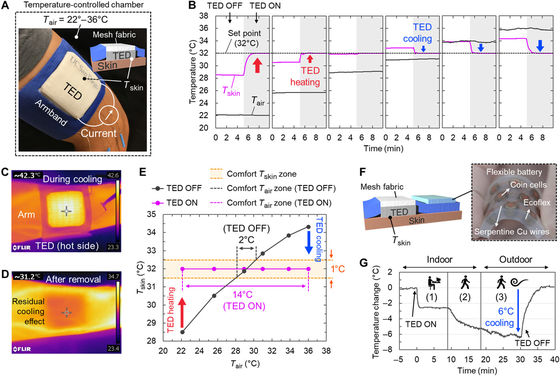Patch-type air conditioner to stick on the skin appears, and the temperature of skin can be cooled more than 10 degrees

Even though 2019 is still in May, temperatures have been
Wearable thermoelectrics for personalized thermodynamics | Science Advances
https://advances.sciencemag.org/content/5/5/eaaw0536

Air conditioner 'in a patch' provides portable cooling: Research Highlights
https://www.nature.com/articles/d41586-019-01576-x
Thermoelectric systems use semiconductors to transfer heat from one side of the device to the other, creating a low temperature region and a high temperature region. By using such a system, it is possible to create a ' compact and easily adjustable cooling system '. However, it has been considered difficult to dissipate heat efficiently with conventional technologies.
Meanwhile, a research team by Renkun Chen and Sheng Xu et al. From the University of California at San Diego used a thermoelectric system to “compact and compact” by embedding semiconductor materials on multiple columns between two stretchable polymer sheets. We succeeded in creating a cooling device (TED) that can be easily adjusted in temperature.
It seems that it was necessary to develop and incorporate a highly flexible battery pack to create TED. According to the development team, the created TED has the effect of cooling the skin by more than 10 degrees. The photo below is a prototype of TED.

The image of B (Thermoelectric sheet) is a sheet in which the semiconductor material on multiple columns is embedded between two stretchable polymer sheets developed by Chen et al. The size is about 5 cm × 5 cm. Next to that is the internal structure of the sheet developed by Chen et al., Where the white part is a stretchable polymer sheet, the brown inside is written as a flexible copper electrode, 'TE pillars' 'Thermoelectric' pillar is. As shown in the image part of A, by attaching the thermoelectric sheet in the vest or arm band etc., it will be able to be used as TED. Since the height of the thermoelectric column is 5 mm, the thickness of the thermoelectric sheet is '5 mm or more and 1 cm or less'.

One stretchable polymer sheet acts as a superheat sheet and the other acts as a cooling sheet, and each sheet is in an insulated state. Because the two sheets are in an insulated state, the superheated sheet can diffuse heat into the air, and the cooling sheet can diffuse cold air into the air.
The image in B is a graph that shows the ambient temperature (T air: black line) and skin temperature (T skin: pink line) when TED is ON (gray) and OFF (white). You should know well that you can keep the temperature constant (32 degrees) by turning on TED. The image in C is a thermal image taken with TED turned on, showing that the TED part is warm (around 42 degrees). The image of D is a thermal image when the skin is cooled with TED, and the temperature of TED part is lower than other parts. The image of E is a measurement of the outside air temperature and the skin temperature when the TED is ON (pink line) and OFF (black line). You can see that TED warms the skin if the outside is cold and cools the skin if it is hot.

According to the science journal Nature, using something like 'personal air conditioners' developed by Chen et al. Can reduce power by as much as 20% compared to existing air conditioners. Not only does this lead to a reduction in power, it also makes it more comfortable outdoors in summer and winter.
Related Posts:







